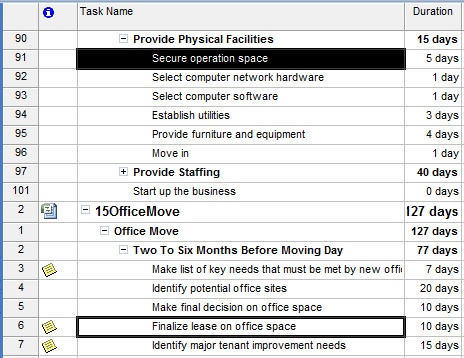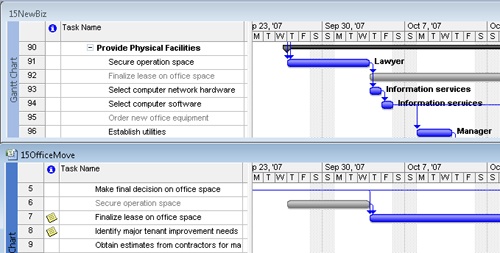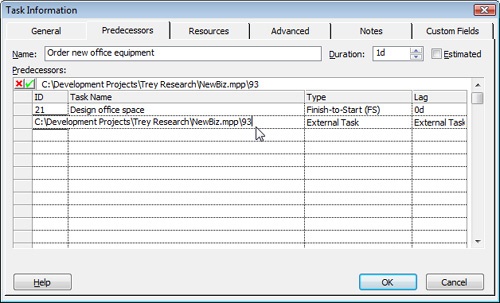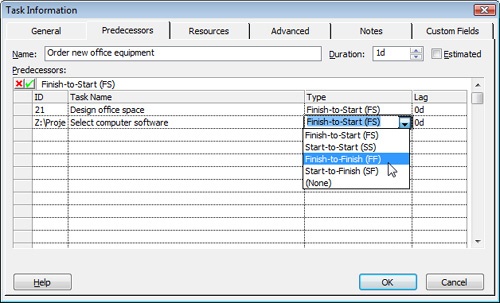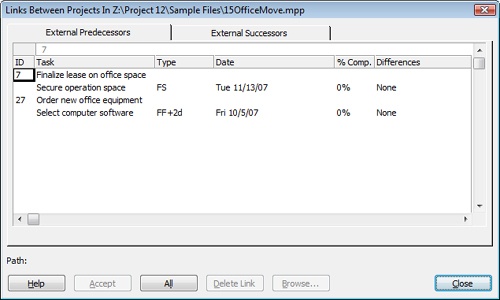You might occasionally find it necessary to share information between project plans, especially when you’re working with multiple projects or adapting information from an old, finished project to a new project you’re beginning to plan. There are a variety of situations in which you might need to share information, as follows:
A task in one project might depend on the start or finish of a task in another project.
Task or resource information or specific fields might need to be copied or moved from one project to another.
Customized project elements, such as views, reports, or calendars, might need to be copied from one project to another.
With Microsoft Office Project 2007, you can easily exchange different types of information between project plans, enabling you not only to model your project appropriately, but also to increase your efficiency by decreasing duplicated entries or development.
When you link two tasks, you’re creating a task dependency or task relationship between them. In the most common link type (finish-to-start), as soon as a predecessor task finishes, its successor task can start.
Tasks don’t have to be in the same project to be linked. You can have external links. An external predecessor is a task in another project that must be finished (or started) before the current task can start (or finish). Likewise, an external successor is a task in another project that cannot start (or finish) until the current task is finished (or started). Creating task relationships with external tasks like these is also referred to as cross-project linking.
There are two methods for linking tasks between different projects. One method uses a temporarily consolidated project. The other has you typing a path.
To link tasks between temporarily consolidated projects:
Open both projects.
Click Window, New Window.
Under Projects, select the two projects that you want to link.
Use the Ctrl or Shift key to select them both at the same time.
In the View list, click the name of the view you want the consolidated projects to appear in.
The Gantt Chart is the default.
Click OK.
The two projects are temporarily consolidated into one.
Click the task in the project you want to become the external predecessor.
Scroll to the task in the other project that you want to become the external successor.
When you find the task, hold down Ctrl and click the task.
Now both the predecessor from one project and the successor from the other project are selected.
On the Standard toolbar, click Link Tasks.
The tasks are linked with a Finish-To-Start task dependency (see Figure 15-1). You can change the dependency type later.
Close the consolidated project without saving it.
Review the two projects that are still open. You’ll see that they now have external predecessors and external successors, as shown by the gray tasks in both projects (see Figure 15-2).
To link a task in one project to a task in another project by entering a path name:
Open both projects.
Close any other projects.
Click Window, Arrange All.
This isn’t required to link, but it enables you to see the tasks in both projects.
In the Task Name field, double-click the task that is to be the successor to the external predecessor.
In the Task Information dialog box, click the Predecessors tab.
In the ID field, type the project path name and task ID of the external predecessor, separated by a backslash (see Figure 15-3).
Figure 15-3. On the Predecessors tab in the Task Information dialog box, enter the path, name, and task ID of the external predecessor in the ID field.
For example, suppose that the path name of the project containing the predecessor is C:Development ProjectTrey Research15NewBiz.mpp, and the ID for the predecessor task is 93 (see Figure 15-4). In the ID field of the Predecessor tab, you’d type C:Development ProjectTrey Research15NewBiz.mpp93 and then press Enter.
Figure 15-4. After you enter the name and ID of the external task, the other fields contain the words External Task and are temporarily not editable.
If you’re linking tasks between two enterprise projects, the projects must both be of the same enterprise version, for example, "published" or "published1," according to the enterprise version control protocol. In addition, you need to precede the string with two angle brackets: <>, for example, <>15NewBiz.mpp.published93.
Note
For more information about enterprise project versions, see the section titled Creating a New Enterprise Project in Chapter 22.
Click OK.
The name of the external predecessor appears in the current project just above the successor task. By default, table text, Gantt bars, and Network Diagram nodes of external predecessors are formatted in gray.
Just as with regular predecessors, you can change the link type from the default finish-to-start to any of the other three link types (finish-to-finish, start-to-start, or start-to-finish). You can also enter lead time or lag time. Use the Predecessors tab in the Task Information dialog box to do this, as follows:
In the Task Name field, click the successor task to the external predecessor and then click Task Information on the Standard toolbar.
In the Task Information dialog box, click the Predecessors tab.
The name of the external task appears in the Task Name field, and the Type and Lag fields are now editable (see Figure 15-5).
To change the task dependency to a type other than finish-to-start, select it in the Type field.
To enter any lead or lag time for the dependency, enter the value in the Lag field.
Lag time is entered as a positive number, whereas lead time is entered as a negative number.
Note
For more information about task dependencies in general, including lead and lag time, see the section titled Establishing Task Dependencies in Chapter 5.
You can see your external links in the different views throughout your project. Whether they’re external predecessors or external successors, by default external tasks are highlighted in gray in sheets. External tasks are also represented with gray Gantt bars and gray Network Diagram nodes.
If you double-click an external task, the project containing that task opens, and the task is selected. You can then review its task information and current schedule. The other project is still open, and you can return to it by double-clicking the corresponding external task in the second project.
Note
If you don’t want external tasks to be visible in your project, you can hide them. Click Tools, Options and then click the View tab. Under Cross Project Linking Options, clear the Show External Successors and the Show External Predecessors check boxes. This setting applies only to the current project.
To review the details about links throughout your project, click Tools, Links Between Projects. The External Predecessors tab in the Links Between Projects dialog box shows information about all external predecessors (see Figure 15-6). Likewise, the External Successors tab shows information about all external successors.
Figure 15-6. The Links Between Projects dialog box shows the pairs of linked tasks along with their link types, finish dates, current percentage complete, along with any available updates.
To see the path and name of an external task, click the task name in the Task field. The path and name appear in the lower-left corner of the dialog box.
There are two fields related to external tasks that you can add to a table or use for sorting, grouping, or filtering. The External Task field, which is a Yes/No (Boolean) field, simply indicates whether the task is external. The Project field contains the name of the project to which this task belongs. For external tasks, the Project field also contains the full path (see Figure 15-7).
Figure 15-7. You can add the External Task or Project fields to a task table to provide information about your cross-project linking.
To add a field to a task table, click Insert, Column and then click the field in the Field Name column.
Whether you add the External Task or Project fields to a table or not, you can sort, group, or filter by these fields. This capability can be handy when you want to see all your external tasks together.
Note
For more information about sorting, grouping, or filtering by a particular field, see the section titled Rearranging Your Project Information in Chapter 4, and Chapter 25.
By default, the Links Between Projects dialog box appears whenever you open a project file that contains external links that have changed since the last time you opened the file. The Differences field alerts you to any changed information, such as a changed name, schedule change, or new progress information (see Figure 15-8).
Figure 15-8. The Links Between Projects dialog box appears when you open a project whose external links have changed, and the change is noted in the Differences field.
To incorporate a change from an external task into your project plan, follow these steps:
In the Links Between Projects dialog box, review the change in the Difference field.
Click the name of the task that has changed and then click the Accept button.
To incorporate multiple changes all at once, click the All button.
When finished accepting changes, click the Close button.
If you click the Close button without accepting the changes, the changes are not yet incorporated into the project. As long as there are differences between the linked task information in the two projects, this dialog box will appear every time you open the project.
You can modify the way differences between projects are updated, as follows:
Open the project containing external links.
Click Tools, Options and then click the View tab.
Under Cross Project Linking Options, clear the Show Links Between Projects Dialog On Open check box.
If this check box is cleared, the Links Between Projects dialog box does not appear when you open the project. Whenever you want to synchronize information between the two projects, you’ll need to click Tools, Links Between Projects and then update links.
If you want external task changes to automatically be updated in your project, select the Automatically Accept New External Data check box.

